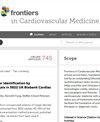稳定型冠心病血管再通患者的心力衰竭生物标志物作为临床结果预测指标
IF 2.8
3区 医学
Q2 CARDIAC & CARDIOVASCULAR SYSTEMS
引用次数: 0
摘要
引言 本研究旨在探讨稳定型阻塞性冠状动脉疾病患者血清中加列特蛋白-3(Gal-3)和N-末端前脑钠尿肽(NT-proBNP)的水平及其预测临床结果的潜力。168 名患者分为三组:经皮冠状动脉介入治疗(PCI)组(64 人)、冠状动脉旁路移植手术(CABG)组(57 人)和无冠状动脉狭窄组(47 人)。结果研究组和对照组的 Gal-3 平均值分别为 19.98 ng/ml 和 9.51 ng/ml (p < 0.001)。研究组和对照组的 Gal-3 值分别为 19.98 ng/ml 和 9.51 ng/ml(p &;lt;0.001),其中三血管疾病组的 Gal-3 值最高(p &;lt;0.001)。研究组的 NT-proBNP 平均值为 401.3 pg/ml,对照组为 100.3 pg/ml(p = 0.159)。三血管疾病患者组的 NT-proBNP 值最高(p = 0.021)。结论 Gal-3和NT-proBNP可作为诊断和评估稳定型阻塞性冠状动脉疾病严重性的额外工具。结论Gal-3和NT-proBNP可作为诊断和评估稳定型阻塞性冠状动脉疾病严重程度的额外工具,而且有助于识别可能发生重大不良心血管事件的高危患者。本文章由计算机程序翻译,如有差异,请以英文原文为准。
Heart failure biomarkers in revascularized patients with stable coronary heart disease as clinical outcome predictors
IntroductionThe aim of this study was to investigate serum levels of galectin-3 (Gal-3) and N-terminal pro-brain Natriuretic Peptide (NT-proBNP) in patients with stable obstructive coronary artery disease, as well as their potential to predict clinical outcomes.MethodsThis was a single-center cross-sectional cohort study. 168 patients were divided into three groups: percutaneous coronary intervention (PCI) group (N 64), coronary artery bypass graft surgery (CABG) group (N 57), and group with no coronary stenosis (N 47). Gal-3 and NT-proBNP levels were measured and the Syntax score (Ss) was calculated.ResultsThe mean value of Gal-3 was 19.98 ng/ml and 9.51 ng/ml (p < 0.001) in the study group and control group, respectively. Highest value of Gal-3 was found in the group of subjects with three-vessel disease (p < 0.001). The mean value of NT-proBNP in the study group was 401.3 pg/ml, and in the control group 100.3 pg/ml (p = 0.159). The highest value of NT-proBNP was found in the group of subjects with three-vessel disease (p = 0.021). There was a statistically significant association between Gal-3, NT-proBNP and occurrence of adverse cardiovascular event (p = 0.0018; p = 0.0019).ConclusionGal-3 and NT-proBNP could be used as an additional tool for diagnosis and severity assessment of stable obstructive coronary artery disease. Furthermore, it could help identify high-risk patients who could experience major adverse cardiovascular events.
求助全文
通过发布文献求助,成功后即可免费获取论文全文。
去求助
来源期刊

Frontiers in Cardiovascular Medicine
Medicine-Cardiology and Cardiovascular Medicine
CiteScore
3.80
自引率
11.10%
发文量
3529
审稿时长
14 weeks
期刊介绍:
Frontiers? Which frontiers? Where exactly are the frontiers of cardiovascular medicine? And who should be defining these frontiers?
At Frontiers in Cardiovascular Medicine we believe it is worth being curious to foresee and explore beyond the current frontiers. In other words, we would like, through the articles published by our community journal Frontiers in Cardiovascular Medicine, to anticipate the future of cardiovascular medicine, and thus better prevent cardiovascular disorders and improve therapeutic options and outcomes of our patients.
 求助内容:
求助内容: 应助结果提醒方式:
应助结果提醒方式:


